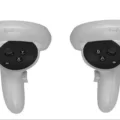The Oculus Quest 2 is a popular virtual reality headset that provides an immersive gaming experience. However, one common issue that users may encounter is blurriness in their display. This can be frustrating and can hinder the overall enjoyment of the VR experience. In this article, we will discuss some possible causes of blurriness on the Quest 2 and how to address them.
First and foremost, it is important to ensure that you are wearing the headset properly. The bottom edge of the headset should rest on your cheekbones, while the standard strap should cup the back of your head. This will help to maintain a secure fit and prevent the headset from slipping off during use. If the headset is too low on your face, the display will appear blurry, so make sure to adjust the position accordingly.
Another potential cause of blurriness is an IPD mismatch. IPD stands for Interpupillary Distance, which is the distance between your eyes. The Quest 2 allows you to adjust the IPD settings to match your own measurements. Using the wrong IPD setting can not only result in blurriness but also lead to VR motion sickness, headaches, and discomfort. To calibrate the IPD, you can move the lenses (without touching them, only touch the cups holding them) to be closer together or further apart. The Quest 2 offers three positions, so try each one and see which setting provides the clearest display.
Additionally, it is important to check the lenses for any smudges or dirt that may be causing blurriness. Clean the lenses gently with a microfiber cloth or lens cleaning solution to ensure optimal clarity. Avoid using harsh chemicals or abrasive materials that could damage the lenses.
In some cases, blurriness may be due to the quality of the content or the limitations of the headset itself. It is worth noting that the Quest 2 has a resolution of 1832 x 1920 pixels per eye, which is lower than some other high-end VR headsets. This lower resolution can contribute to a slightly less sharp image.
If you have tried the above steps and are still experiencing blurriness, it may be worth reaching out to Oculus Support for further assistance. They can provide personalized troubleshooting and help determine if there is a hardware issue with your headset.
Blurriness on the Oculus Quest 2 can be caused by various factors, including improper headset positioning, an IPD mismatch, dirty lenses, or limitations of the device itself. By ensuring proper headset fit, calibrating the IPD, and keeping the lenses clean, you can improve the clarity of your VR experience. If issues persist, contacting Oculus Support may be necessary.

Is It Normal for VR to Be Blurry?
It is normal for virtual reality (VR) to appear blurry if the headset is not properly positioned on your face. The blurriness can occur if the headset is too low on your face or if the lenses are not aligned correctly with your eyes.
To ensure a clear VR experience, it is important to wear the headset properly. The bottom edge of the headset should rest on your cheekbones, while the standard strap should cup the back of your head. This positioning helps to align the lenses with your eyes and reduce blurriness.
If the headset is too low on your face, the display will likely appear blurry because the lenses are not in the correct position to focus properly. To fix this, adjust the headset so that it sits higher on your face, ensuring a clear view of the display.
Additionally, make sure to adjust the IPD (interpupillary distance) setting on your VR headset if it has that feature. IPD refers to the distance between your eyes, and adjusting this setting can further enhance the clarity of the VR experience.
It’s worth noting that some blurriness may still be present in certain VR experiences due to the limitations of current technology. However, by wearing the headset properly and adjusting the settings, you can minimize blurriness and enjoy a clearer VR experience.
It is normal for VR to appear blurry if the headset is not positioned correctly on your face. Follow the guidelines for wearing the headset properly, adjust the IPD setting if available, and you should be able to minimize blurriness and enjoy a clearer VR experience.

Why is Your Oculus Headset So Blurry?
There are several reasons why your Oculus headset may be blurry. It could be due to:
1. Incorrect IPD (Interpupillary Distance) settings: IPD refers to the distance between your eyes, and if it is not properly calibrated, it can lead to blurriness. Make sure to set the IPD correctly for your eyes.
2. Improper positioning: The position of the headset on your face can affect the clarity of the display. Ensure that the headset is properly adjusted and aligned with your eyes to optimize the focus.
3. Dirty or smudged lenses: Over time, the lenses on your Oculus headset can accumulate dirt, fingerprints, or smudges, which can result in blurry visuals. Clean the lenses regularly using a microfiber cloth to maintain clarity.
4. Low resolution or graphics settings: If the resolution or graphics settings of the VR application or game you are using are set too low, the visuals can appear blurry. Adjust the settings to a higher resolution or quality if possible.
5. Insufficient processing power: Blurriness can also occur if your computer or device does not have enough processing power to handle the VR content smoothly. Ensure that your system meets the recommended specifications for running VR applications.
6. Inadequate headset fit: If the headset does not fit properly on your head, it may cause the lenses to be misaligned with your eyes, resulting in blurriness. Adjust the straps and ensure a snug fit for optimal clarity.
7. Faulty hardware or lens defects: In some cases, blurriness can be caused by hardware issues or defects in the lenses themselves. If none of the above solutions improve the clarity, it may be necessary to contact Oculus support for further assistance or consider a replacement if the headset is still under warranty.
Remember, addressing the IPD settings and ensuring proper positioning, lens cleanliness, and hardware functionality are crucial steps to mitigate blurriness in your Oculus headset.
Why is Your Oculus Quest 2 Pixelated?
The Oculus Quest 2 may appear pixelated due to a few reasons:
1. Low Screen Resolution: The Quest 2 has a resolution of 1832 x 1920 pixels per eye. While this is considered high for a standalone VR headset, it may not be as sharp as some high-end PC VR headsets. The screen-door effect, where you can see the gaps between pixels, can contribute to the perception of pixelation.
2. IPD (Interpupillary Distance) Setting: The IPD setting determines the distance between the lenses to match the distance between your eyes. If the IPD setting is incorrect, it can result in a blurry or pixelated image. Ensure that you adjust the IPD setting to match your own eye distance for a clear view.
3. Incorrect Lens Position: The Quest 2 allows you to physically adjust the position of the lenses. If the lenses are not properly aligned with your eyes, it can lead to a pixelated image. Make sure the lenses are positioned correctly by moving them closer together or further apart to find the clearest view.
4. Dirty Lenses: Fingerprints, smudges, or dust on the lenses can significantly impact the image quality. Clean the lenses using a microfiber cloth or lens cleaning solution to ensure a clear view.
5. Graphics Settings: If you are experiencing pixelation in specific games or apps, it could be due to lower graphics settings. Some developers may prioritize performance over visual quality, resulting in a slightly pixelated image. Adjust the in-game graphics settings to a higher quality if available.
6. Streaming Quality: If you are streaming content to your Quest 2, the quality can be affected by your internet connection. Insufficient bandwidth or network congestion can lead to pixelation or a lower-quality image. Ensure you have a stable and high-speed internet connection for optimal streaming quality.
By considering these factors and making the necessary adjustments, you can minimize the pixelation and enjoy a clearer VR experience with your Oculus Quest 2.
Conclusion
If you are experiencing blurriness on your Oculus Quest 2 headset, there are a few potential causes to consider. Firstly, ensure that you are wearing the headset properly, with the bottom edge resting on your cheekbones and the strap securely cupping the back of your head. This will help prevent the headset from slipping off during use.
Another common cause of blurriness is an IPD mismatch. The IPD, or interpupillary distance, refers to the distance between your eyes. It is important to calibrate the IPD settings on your Quest 2 to ensure a clear and comfortable viewing experience. You can adjust the lenses by moving them closer together or further apart using the cups that hold them. There are three positions to try, so experiment with each to find the one that provides the clearest vision.
Additionally, it is important to regularly clean the lenses of your Quest 2 to ensure optimal visual clarity. Any smudges or dirt on the lenses can cause blurriness and reduce the overall quality of your virtual reality experience. Use a microfiber cloth or lens cleaning solution specifically designed for VR headsets to gently clean the lenses.
By following these steps and ensuring proper headset fit, IPD calibration, and lens cleanliness, you should be able to resolve any issues with blurriness on your Oculus Quest 2. Enjoy your virtual reality adventures with clear and immersive visuals!












